Little bucktails swap
This swap has gathered a collection of patterns from diverse sources, including Maine regional favorites, patterns from the wider northeast, regional patterns from the West and from Alberta, and newly created patterns. They all share three things in common - hair wings, small hooks, and a tremendous attraction to brook trout.
- EDSON LIGHT TIGER, MICKEY FINN
- ATOM BOMB
- ROYAL COACHMAN HAIRWING STREAMER
- LLAMA
- THIRTEENTH LAKE
- ROACH RIVER ROBBER
- SOUTH BRANCH CHUB
- GREEN PARROT
- MCNAB STREAMER
- KATADIN IRONWORKS SIMPLE SQUIRREL
- GRAY FOX STREAMER
- BLACK GHOST, HAIRWING VERSION
- HELL CAT
- SHUSHAN POSTMASTER
- MACGREGOR
- RED & WHITE #1 (ORIGINAL), RED & WHITE #2 (POPULAR), GOVERNOR AIKEN
- PROFESSOR, WARDEN'S WORRY
- EDSON TIGER DARK
- BLUE BACK
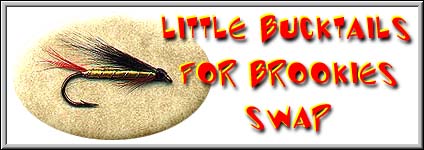
A swap organized over the Streamers@ mailing list
Back a few months ago on the Streamers@ mailing list, one of the discussion-group participants (don't worry Bob, you'll go nameless) admitted that he had no small bucktails in his streamer box; and querried the group to recommend patterns. Subsequently, over a dreary January weekend, with 74 days, 9 hours & a few assorted minutes until opening day in Maine, the idea for this swap was spawned. In addition to gracing these pages, the swap served to fill quite a few streamer boxes with a delightful variety of "little bucktails for brookies."
This swap has gathered a collection of patterns from diverse sources, including Maine regional favorites (such as the Warden's Worry and Edson Tigers), patterns from the wider northeast (e.g. the Shushan Postmaster), regional patterns from the West and from Alberta (Atom Bomb & McNab), old Atlantic salmon fly adaptations (the Professor), and newly created patterns (South Branch Chub, Grey Fox, Green Parrot). They all share three things in common - hair wings, small hooks, and a tremendous attraction to brook trout.
EDSON LIGHT TIGER, MICKEY FINN
Submitted By Wes Autio

EDSON LIGHT TIGER
| HOOK | Mustad 3665A, #10 |
| THREAD | Uni-Thread, 8/0, black |
| TAIL | Section of barred wood duck, tied to show two bars |
| BODY | Four strands peacock herl, twisted with tying thread |
| WING | Yellow buck tail, with red hackle tips tied on top, extending to about 1/3 of the length of the buck tail |
| CHEEKS | Jungle cock, only the eye showing |
| HEAD | Black, lacquered with penetrating clear head cement, and then with black Cellire |

MICKEY FINN
| HOOK | Mustad 3665A, #10 |
| THREAD | Uni-Thread, 8/0, black |
| BODY | Flat silver tinsel (Uni-Mylar, #14, 1/32"), ribbed with fine oval tinsel (DMC Light Silver Embroidery Thread) |
| WING | Buck tail, tied in three equally sized bunches, red between two yellow |
| HEAD | Black, lacquered with penetrating clear head cement, and then with black Cellire |
Wes' Comments
Edson Light Tiger:
The Edson Light Tiger was created by William Edson of Portland, ME in 1929. Joseph Bates (Streamer Fly Tying & Fishing) suggests that the Edson Light Tiger and Edson Dark Tiger are "among the most successful for all species of game fish."
Tying Instructions
1. Start the thread behind the eye of the hook and lay down an even base of thread wraps to the hook bend.
2. Select a section of barred wood duck feather that is about 3/16" wide, showing at least two bars. Even the tip of the feather and fold it. Tie it to the top of the hook, allowing two bars to show. Tie the base of the section to the top of the hook by wrapping the thread back to about 3/16" from the eye.
3. Select four strands of peacock herl and tie to the top of the hook. Hold in on top of the hook and wrap the tread back to the hook bend over the herl. Twist the herl and thread together and wrap the herl/thread
around the hook to about 3/16" from the eye.
4. As the start of the wing, select a bunch of yellow bucktail, even it, and tie it to the hook, using the loop technique. The tips of the bucktail should extend to the end of the tail.
5. Apply a coat of penetrating, clear head cement before finishing the head, and allow it to dry.
6. Tie red hackle tips to the top of the wing so that they extend approximately 1/3 of the length of the bucktail.
7. Complete the head with thread wraps, and cement it again with penetrating, clear head cement. Allow it to dry, and finish the head with black Cellire for a glossy look.
Mickey Finn:
The detail of the Mickey Finn's origin is a bit obscure. The creator is unknown, but was at one time produced by William Mills & Sons but not named. Bates (in Streamer Fly Tying & Fishing) described the
history of its naming. Apparently, John Alden Knight received the fly from Junior Vanderhoff at a fishing club near Greewich, NY in 1932. Four years later, in 1936, Mr. Knight used it on a fishing trip near Toronto,
and due toits success, named it the Assassin. Gregory Clark, who also was on that trip, renamed it Mickey Finn, presumably because of the recent death of Rudolph Valentino by a dose of barbiturates (that is, he was
slipped a Mickey Finn). Over the next few years, it was popularized in the outdoors press, and since has become a staple streamer for brook trout.
Tying Instructions:
1. Start the thread behind the eye of the hook and lay down an even base of thread wraps to the hook bend. Wind thread back to about 3/16" behind the eye.
2. Tie the oval tinsel to the underside of the hook, and wrap thread over it back to the beginning of the bend, keeping the tinsel on the underside of the hook. Wind thread back to about 3/16" behind the eye.
3. Tie in the flat tinsel, and wrap it to the bend of the hook and back to the place where it was originally tied in, making sure that no thread shows through the tinsel. Tie the end of the tinsel and cut it off.
4. As the start of the wing, select a small bunch of yellow bucktail, even it, and tie it to the hook, using the loop technique as described by Martin Joergensen. The tips of the bucktail should extend just beyond the back of the hook
5. Secondly, select a small bunch of red bucktail (about the same size as the yellow), even it, and tie it on top of the yellow bunch, again using the loop technique.
6. For the last portion of the wing, select another small bunch of yellow bucktail (again, about the same size as the previous two bunches) and tie it on top using the same procedure. This loop technique helps keep
the colors separate, but you must be careful not to roll one bundle around the other, obscuring the lower color.
7. Apply a coat of penetrating, clear head cement before finishing the head, and allow it to dry.
8. Complete the head with thread wraps, and cement it again with penetrating, clear head cement. Allow it to dry, and finish the head with black Cellire for a glossy look.
ATOM BOMB
Submitted By Kerry Brown

| THREAD | olive or black |
| TAIL | yellow hakle tips or barbules |
| BODY | silver tinsel yarn (calls for mylar piping) |
| THROAT | brown hackle as beard |
| UNDER WING | yellow marabou |
| OVER WING | white calftail (calls for bucktail) |
ROYAL COACHMAN HAIRWING STREAMER
Submitted By Ben Taylor
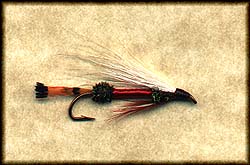
| HOOK | Mustad 9575 #8 |
| THREAD | black 6/0 |
| TAIL | golden pheasant tippet fibers |
| BODY | red floss, with peacock herl butt (3 strands) at both ends |
| WING | white goat hair |
| THROAT | brown hackle fibers |
Comments from Ben & his proud dad
The Royal Coachman Bucktail is a popular adaptation of the traditional wet fly. The substitution of white goat hair for the wing adds translucency & action to the pattern when tied in smaller sizes.
Twist the peacock herl with the tying thread before wrapping it on so it won't unravel if the fish bite it.
Ben is the 12 year-old son of the swapmeister, and clearly the prize of his dad's eye with this offering.
LLAMA
Submitted By Gordon Dale

| HOOK | TMC 3769 |
| THREAD | 8/0 Black |
| RIB | Oval tinsel |
| TAIL | Grizzly Hen Hackle |
| BODY | Red wool Dubbing |
| WING | WoodChuck including underfur |
| HACKLE/COLLAR | Grizzly hen tied back |
| COMMENTS | Be sure to use the Woodchuck underfur in the wing; it makes the wing breath or pulsate. I used a turn of red flash dubbing just behind the collar to help attract the brookies. |
THIRTEENTH LAKE
Submitted By Scott Daskiewich

| THREAD | Black |
| TAIL | Golden Pheasant tippet |
| BODY | Orange Floss |
| RIB | Flat Gold Tinsel |
| WING | Black over Orange bucktail |
Comments
This fly is named after a small lake on the edge of the Siamese Ponds wilderness in the south central Adirondacks. Garnet mines punctuate the mountains surrounding the lake. Three species of trout inhabit the lake as well as landlocked salmon so I suspect this fly would be versatile enough to use for all. I plan on doing a trolling size model for fall landlockeds.
ROACH RIVER ROBBER
Submitted By Kelvin Hartley

| HOOK | 6x |
| THREAD | black |
| BODY | Red Uni-stretch |
| THROAT | natural brown deer back hairs (sparse) |
| WING | Gray Squirrel tail hair |
| COMMENTS | Invented by Dan Legere of Maine Guide Fly Shop in Greenville. |
SOUTH BRANCH CHUB
Submitted By Aaron Hirschhorn

| HOOK | 4XL Streamer, straight eye, #6 - 10 |
| THREAD | Black 6/0 or 8/0 |
| BODY | Gold Mylar Tinsel (Bill's Bodi-Braid) |
| RIB | Fine Gold Wire (none) |
| WING | Black & White Monga Ringtail Hair, topped by a Teal Flank Feather, flatwing style |
| HEAD | Jungle Cock eyes (painted eyes). |
Aaron's Comments
The South Branch Chub was originated by Bob Jacklin while he was in highschool in New Jersey. His thrust was for a fly to use in small streams and ponds for native brook trout, particularly in the South Branch of the Raritan. He now claims that it is good not only in the east, but also out west.
Tying instructions (for my variation):
1. Attach thread at eye and wrap back a couple of eye lengths.
2. At this point tie on the gold Bodi-Braid and run thread to bend and then back up to this point.
3. Wrap Bodi-Braid up to wating thrad and clip excess.
4. Tie in a sparse amount of White Monga Ringtail for the base of the wing.
5. Over the white hair tie in an equal amount of Black Monga Ringtail.
6. The top of the wing is the most important part of the fly. Drape a small teal flank feather to form the back of the fly. If using Jungle Cock, tie them on at this time.
7. Cement the head and apply a touch of dubbing wax to the wing to groom and give it a nice sparse look.
8. Apply yellow eye with black pupil and cement when dry.
GREEN PARROT
Submitted By Stan Jakubaszek
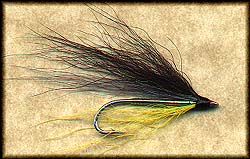
| HOOK | 4x long streamer |
| BODY | pearl mylar tinsel |
| THROAT | yellow bucktail |
| WING | dark oliveover gray bucktail |
| CHEEKS | JC (optional) |
| HEAD | black |
| COMMENTS | This pattern, originated by Ken Thayer, tends to work well as a general searching pattern for most seasons. The colors are very 'fishy' and are suggestive of a large variety of small minnows. Tie the pattern in sizes from 2 thru 10 sized to the prevalent bait fish in the stream that you fish. |
MCNAB STREAMER
Submitted By Craig Jenne

| HOOK | Mustad #6, 4XL streamer |
| THREAD | black |
| TAG | flat silver tinsel |
| BODY | rear 1/3, yellow floss; front 2/3, black floss |
| RIB | flat silver tinsel (only on front 2/3) |
| THROAT | black hackle |
| WING | moose body hair |
| COMMENTS | I have been tying a few hair wing streamers and I am partial to this little (#6) black and yellow number. It, to my knowledge, is not a recognized pattern but is loosely based both on the green-butt black bear salmon fly and on descriptions of some of my fishing buddies favourite streamers from out in Alberta. |
KATADIN IRONWORKS SIMPLE SQUIRREL
Submitted By Ron McKusick

| THREAD | brown 6/0 |
| HOOK | 4x size 8 |
| BODY | reddish brown yarn |
| THROAT | Red rabbit fur |
| WING | gray squirrel tail hair |
| COMMENTS | Showed to me by a fellow Trout Unlimited member who uses this fly every time he fishes KI. |
GRAY FOX STREAMER
Submitted By Robb Nicewonger

| BODY | Silver mylar |
| THROAT | Red krystal flash |
| UNDERWING | Pearl krystal flash |
| WING | Squirrel |
| TOPPING | Peacock Herl |
| HEAD | Black with painted orange eye |
| COMMENTS | Originated by Ken Thayer. This is slightly different than Ken's fly--I made the pearl xtal flash an underwing instead of a belly and added an orange eye because I like it (and it covers up the big head). I haven't fished this fly yet, but I (and the fish) do like squirrel tail streamers! |
BLACK GHOST, HAIRWING VERSION
Submitted By Bob Petti

| HOOK | Mustad 3665A, #6 |
| THREAD | Black |
| TAIL | Yellow Hackle Barbules |
| RIB | Flat Silver Mylar Tinsel |
| BODY | Black Uni-Stretch |
| THROAT | Yellow Hackle Barbules |
| WING | White Kid Goat (original was white hackles) |
Bob's Comments
Originator: Herb Welch Tying tip - Use the uni stretch in a bobbin as thread and tie the tinsel in as you're winding back to the bend, and the tail in as you "turn around". Tie off with black thread and wind the tinsel forward. Finish the fly as normal.
HELL CAT
Submitted By Doug Saball
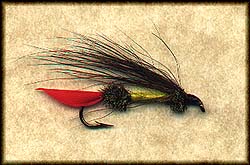
| HEAD | Black tying thread. |
| BODY | Yellow Chenille with peacock eyed tail feather fibers at each end much like the peacock fiber bunches on a Royal Coachman body. |
| WING | A small bunch of black bucktail tied over it. |
| SHOULDER | Jungle cock. |
| TAIL | a small section of red goose or duck wing quill feathers or a bunch of red saddle hackle fibers. |
| COMMENTS | Invented by M.W. Burlingame; this is as it appeared in Herter's pattern book. I used yellow floss because I didn't have yellow chenille. |
SHUSHAN POSTMASTER
Submitted By Stack Scoville

| TAIL | Brown mottled turkey wing (I used the "biot side" of the quill as it seemed to hold its curve a little better) |
| RIB | Gold Tinsel |
| BODY | Light yellow silk floss-tapered |
| HACKLE | Red duck wing feather fibers, long, beard (I used dyed turkey tail or, on some of the flies, goose shoulder) |
| WING | Red fox squirrel tail |
| CHEEKS | Jungle cock- short (Omitted on these flies due to lack of quality material) |
| HEAD | Black lacquered |
>Stack's Comments
The taper to the body is a modification of the technique Mike Radencich described in his excellent book on tying the Classic Salmon Fly. I used two strands of cotton embroidery floss and tied it in about 3/5 of the way toward the head. Keeping the two strands side-by-side, I wrapped forward to 4/5 then back over the first wraps to 2/5 from the tail then forward to the wing tie in point and tied off the cotton. Then with tying thread I wrapped backward, with VERY flat thread, filling in any gaps all the way to the tail and then back to the wing tie in point. I then took Kreinik silk tied it in, wrapped all the way back to the tail and then forward, making sure that there were no lumps or bumps, keeping the floss absolutely flat, and then tied it off. Next, I took an small test tube and "burnished" the silk to flatten it even further. This technique is also described in Mike's book. After wrapping the tinsel forward and tying it off, I covered the entire body with clear Cellire lacquer. After drying, I tied in the throat, much like a small wet fly wing. The squirrel follows. Finally the head is cemented, and covered with 2-5 coats of Sally Hansen Hard as Nails nail lacquer.
MACGREGOR
Submitted By David Talley

| HOOK | Mustad 3665A #8 |
| TAG | Flat silver tinsel |
| TAIL | GP crest |
| BODY | Burnt Orange Floss |
| RIB | Flat silver tinsel |
| THROAT | Guinea Fowl (slightly long |
| WING | Grey Squirrel tail |
Comments
According to Bates' Streamer Fly Tying and Fishing, the pattern originated in Scotland. The original recipe calls for a burnt orange chenille body. I didn't have any of that, so I used floss, which I think I like better anyway. The original also calls for a throat of grizzly hackle. I substituted guinea fowl.
RED & WHITE #1 (ORIGINAL), RED & WHITE #2 (POPULAR), GOVERNOR AIKEN
Submitted By Bob Skehan
RED & WHITE #1 (ORIGINAL)
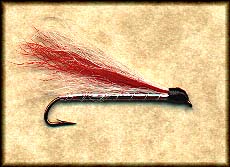
| HOOK | Mustad 3665A Size 12 |
| THREAD | black |
| BODY | Flat silver mylar |
| RIB | fine oval silver tinsel |
| WING | Small equal bunches of white, then red, then white bucktail. |
RED & WHITE #2 (POPULAR)

| HOOK | Mustad 3665A Size 12 |
| THREAD | red |
| BODY | Flat silver mylar |
| RIB | fine oval silver tinsel |
| WING | Small bunch of white bucktail, over which is an equal bunch of red bucktail, over which are 4-5 strands of peacock herl. |
GOVERNOR AIKEN
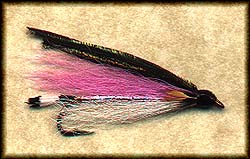
| HOOK | Mustad 9575 #10 |
| THREAD | black |
| TAIL | White-Barred wood duck flank |
| BODY | Flat silver mylar |
| RIB | fine oval silver tinsel |
| THROAT | White bucktail to hook bend, then a narrow strip of red duck quill 1/2 body length |
| WING | Lavender bucktail, over which are 3-4 strands of peacock herl. |
| CHEEKS | Jungle Cock (optional) |
Comments
Red And White
The two variations of the Red and White bucktail presented here show the original dressing which is pretty much a Mickey Finn with white bucktail substitued for the yellow, and the modern popular version which has the top layer of white bucktail replaced by peacock herl. I have to confess I haven't fished the original version at all since I'm generally a certifiable "peacock herl topping" junkie. Both patterns adapt well to all hook sizes, including tandem rigs for trolling. It's a very effective pattern all year long, but particularly in spring just after ice-out on Maine's lakes and ponds. I substituted calftail for the bucktail in this small version. Many times a white eye with black pupil is painted on the head of this pattern.
Governor Aiken:
This pattern, named to honor former Governor George D. Aiken of Vermont, is very similar to the Magog Smelt pattern, this bucktail is a must have for landlocked salmon fishing in my opinion. Some folks substitute a mallard flank shoulder for the jungle cock cheeks, particularly in larger trolling sizes...(making it even more like the Magog)...though I don't tie this pattern with either of them. Like the Red and White, it adapts nicely to all hook sizes and is a very popular trolling pattern tied in tandem. I used calftail in this particular sample as it was better suited to the size 10 hook. Note the peacock herl topping...see my comments above regarding my herl addiction. A peek into my streamer box would see this pattern sporting eyes painted white with black pupils.
PROFESSOR, WARDEN'S WORRY
Submitted By Will Taylor
PROFESSOR

| HOOK | Mustad 9672 #8 |
| THREAD | black uni 8/0 |
| TAG | fine oval gold tinsel |
| TAIL | red hackle fibers |
| RIB | fine oval gold tinsel |
| BODY | yellow floss |
| WING | grey squirrel |
| THROAT | brown hen hackle fibers |
WARDEN'S WORRY
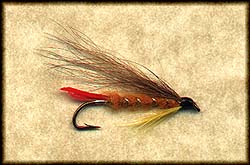
| HOOK | Mustad 9575 #8 |
| THREAD | black uni 8/0 |
| TAG | flat silver tinsel, #16 (also tied with gold tinsel) |
| TAIL | narrow strip of red duck wing quill, long |
| RIB | medium oval gold tinsel |
| BODY | yellow-orange dubbing (I used rabbit), or wool, picked out |
| WING | natural brown bucktail from top of tail |
| THROAT | yellow hen hackle fibers |
Comments
Professor
My dad had a wonderful box of brook trout flies when I was a kid, many of them tied on eyeless hooks with gut snells. This squirrel-winged version of the Professor was one of the patterns I recall, along with a strip-wing version using a woodduck flank wing. This is one of my favorite patterns for swirling into pint-sized pools on tumbling mountain streams. I just have to tie one on my tippet to go back to those barefoot days on Beehunter Creek.
Warden's Worry:
Developed by warden Joseph Stickney, of Saco, Maine; an old standard since the 1920's. I originally wanted to tie this with a squirrel wing, but a traditionalist on the list shamed me into "doin' it proper." I'm glad he did - it looks a lot better the way that Stickney intended it. (I do have a couple with fox squirrel wings in my bucktail wallet, but I'll be careful who I show those to).
EDSON TIGER DARK
Submitted By Clyde Watson
EDSON TIGER DARK (Original)

| HEAD | Black or Yellow lacquer |
| TAG | Flat Gold Tinsel |
| TAIL | Two Yellow saddle Hackle Tips |
| BODY | Yellow Chenille |
| WING | Fox Squirrel |
| THROAT | Two Red hackle tips |
| CHEEKS | Gold Metal "Edson" Cheeks |
EDSON TIGER DARK (My Version)
| HEAD | Blk or Yellow Thread |
| TAG | None |
| TAIL | Yellow Hackle Fibers |
| BODY | Yellow Chenille |
| WING | Squirrel Tail (Not sure if it's a Fox squirrel - red with black bands) |
| THROAT | Red Hackle fibers |
| CHEEKS | None |
Clyde's Comments
According to Bates' book, Edson incorporated "Edson" cheeks (gold metal cheeks) to replace the expensive Jungle cock eyes. Also of the five examples in Bates' book, I don't think any of them are tied identicle. He used various hackle types for the tail and even used furnace hackle for the squirrel wing. Seeing this I don't feel as bad for my simplified version. For me it's easier to tie, and still closely resembles the original pattern.
BLUE BACK
Submitted By Roger Whitcomb
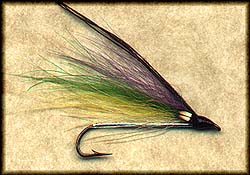
| HOOK | Mustad # 9575 Size 8 |
| THREAD | Danville prewaxed 6/0 |
| HEAD | Black |
| BODY | Medium silver tinsel |
| WING | Sparse white Polar Bear over which sparse yellow Polar Bear over which sparse green Polar Bear over which sparse blue Polar Bear over which 3-4 strands of peacock herl.Original pattern uses bucktail in place of Polar Bear and is necessay in the larger trolling sizes. |
| CHEEKS | Jungle Cock (original pattern has painted eyes-I prefer the JC in the casting sizes using painted black over white eyes on the trolling sizes) |
Roger's Comments
I use this pattern in casting and trolling sizes including tandems. It works well right after ice out for squaretails in the pattern and size I have done for the swap however I do use it in size 10 & 12 also. I
believe that the natural flare and translucency of Polar Bear is a real attractor for squaretails and the other Trout & Salmon species as well. I normally fish it on the surface at that time and then as the water
warms up change to a sinking line. It also works well for Lakers during the summer months fished as a tandem @ 50'-60' either dead drifting or trolling.
Read more about why you should register.
More content from the front page
Since you got this far …
… I have a small favor to ask.
Long story short
Support the Global FlyFisher through several different channels, including PayPal.
Long story longer
The Global FlyFisher has been online since the mid-90's and has been free to access for everybody since day one – and will stay free for as long as I run it.
But that doesn't mean that it's free to run.
It costs money to drive a large site like this.
See more details about what you can do to help in this blog post.







































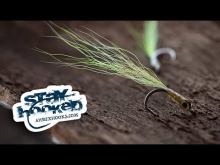

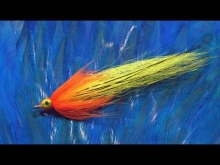


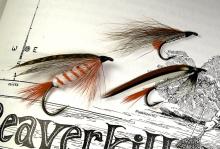




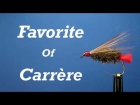








Comments
I never knew the Lla
I never knew the Llama was a wet. Only knew it to be a streamer.
Martin, Looks like
Martin,
Looks like you "showed" him. ;-)
Paul
Ray, No such word
Ray,
No such word...?
It might not be correct above, but the word certainly exists. "Ray showed himself to be an excellent fly-caster" is absolutely correct as far as I know - but then again, I'm not a native English speaker, so I might of course be wrong.
And reading a little about the word, showed is often referred to as "technically correct" but in practice, shown rules the day.
Well, life is full of irregularities...
Martin
Past tense of the wo
Past tense of the word "show" is "shown". No such word as showed.
You forgot that the
You forgot that the Llama fly is a streamer